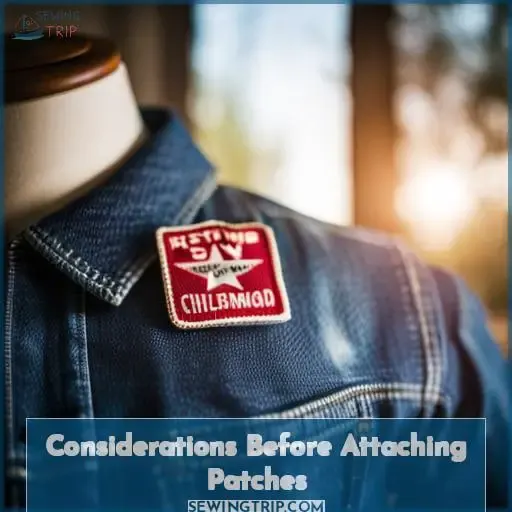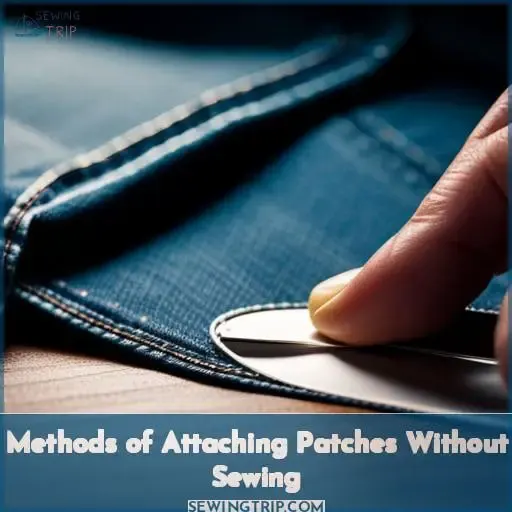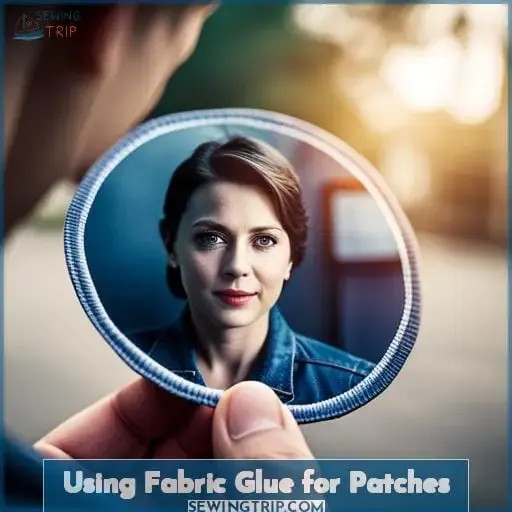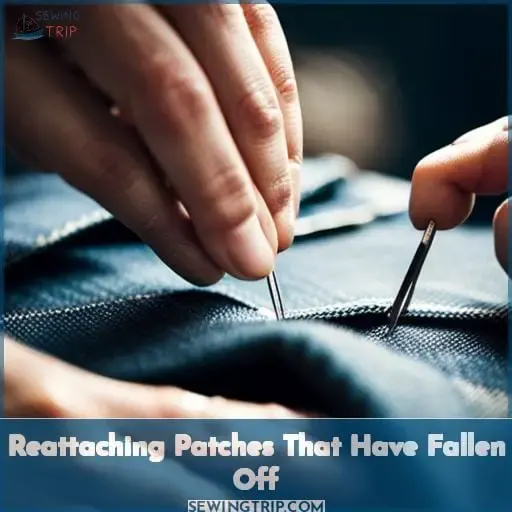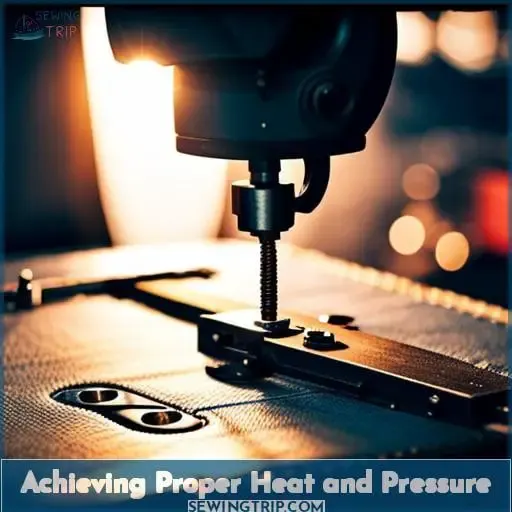This site is supported by our readers. We may earn a commission, at no cost to you, if you purchase through links.
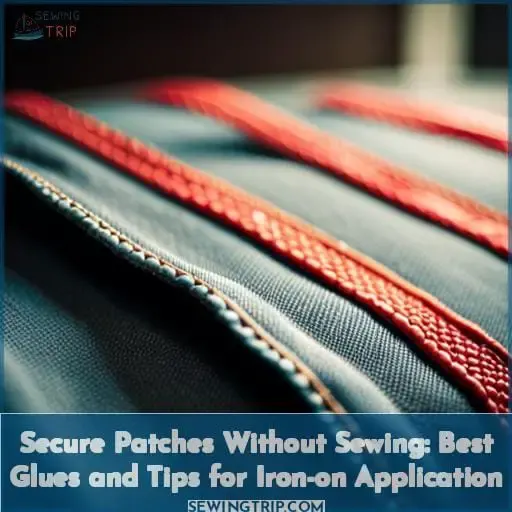
Before you toss ’em, try this glue trick.
With the right adhesive and prep, your patches will stay put through countless washes.
We’ll explore foolproof application techniques to keep your fabrics intact and patches firmly fastened.
Let your personality shine through with secure, customizable flair—no needle or thread required.
Table Of Contents
- Key Takeaways
- Considerations Before Attaching Patches
- Methods of Attaching Patches Without Sewing
- Using Fabric Glue for Patches
- Reattaching Patches That Have Fallen Off
- Achieving Proper Heat and Pressure
- Successfully Securing Patches
- Attaching Patches to Different Fabrics and Items
- Frequently Asked Questions (FAQs)
- Conclusion
Key Takeaways
- Check fabric and adhesive compatibility before application
- Select appropriate, high-quality fabric adhesive for permanence
- Follow manufacturer guidelines for application method and drying time
- Assess optimal procedure (iron-on, glue, Velcro) based on fabric type and design
Considerations Before Attaching Patches
Before adhering any patch, always check fabric compatibility and select the best glue for permanence.
Carefully follow product directions on application method and drying time to securely fasten your patch without stitches.
Material Compatibility Checks
Before attaching a patch, check if the materials are compatible.
Choose a small, inconspicuous area of the fabric to apply a tiny bit of glue or heat.
Observe if the fabric or patch materials warp, stain, or deteriorate.
Custom patches allow full control over material selection.
When using pre-made patches, reference manufacturer guidelines on fabric compatibility.
Thoughtful design and preparatory checks ensure a long-lasting, quality finished project.
Adhesive Selection Guidelines
After checking that the patch material is compatible with your fabric, you’ll need to select an appropriate adhesive for secure attachment.
Consider factors such as:
- Adhesive compatibility
- Fabric suitability
- Application precision
- Drying time
Choose a high-quality fabric adhesive that ensures long-lasting patch longevity.
Following these guidelines will help you achieve a strong bond between the patch and your garment without sewing or compromising on quality.
Optimal Application Methods
With patch materials and adhesives chosen, determine the best attachment technique for your project by evaluating iron-on, glue, Velcro, and fabric adhesive procedures.
Consider the following factors:
- Heat source needed
- Fabric type
- Design intricacy
- Adhesive washability/flexibility
- Plans for removal
| Heat Source | Fabrics |
|---|---|
| Iron | Cotton, denim |
| Heat press | Most fabrics |
| Hair dryer | Delicate fabrics |
Methods of Attaching Patches Without Sewing
When you want to apply a patch but lack sewing skills, don’t fret!
There are handy methods like iron-on application, fabric glues, and velcro that securely fasten patches sans stitches.
Let’s explore the easiest no-sew approaches to decorating your garments and accessories with fun patches:
- Iron-on application: This method is quick and easy, requiring only an iron and a pressing cloth. Simply place the patch on the desired location, cover it with the pressing cloth, and apply heat with the iron according to the manufacturer’s instructions.
- Fabric glues: Fabric glues provide a strong and permanent bond between the patch and the fabric. Apply a thin layer of glue to the back of the patch, press it onto the desired location, and allow it to dry completely.
- Velcro: Velcro is a versatile and removable option that allows you to easily attach and detach patches. Sew or glue a piece of velcro to the back of the patch and the corresponding piece to the garment or accessory.
Iron-on Method
When attaching patches via ironing, start by preheating your iron to 350 degrees Fahrenheit.
Place a towel over the patch and press for 60 seconds.
Check that the patch is securely attached.
The iron-on method works well for cotton and denim fabrics.
Position your patch carefully, then apply heat as directed to activate the adhesive backing.
Use a pressing cloth to protect intricate patches.
Check edges to ensure a tight seal.
Allow it to cool completely before wearing or washing to maximize durability.
Glue or Fusible Web Method
You can use fabric glue or fusible web to attach a patch as a last resort if other methods won’t work.
Apply glue carefully to the patch’s back and press firmly.
Let the glue set for an hour, then test the edges.
Allow 24 hours for complete drying and bonding before wearing.
Choose quality glue to prevent deterioration.
Consider creative patch placement with velcro as an alternative.
Velcro Method
One can also attach patches using the Velcro method.
Glue or sew Velcro patches onto the clothing or patch.
Then, securely fasten the Velcro patch on all sides.
This allows you to attach and remove the patch as desired without any sewing.
The Velcro versatility enables quick patching, reusable attachment, and easy removal for customizable options.
Using Fabric Glue for Patches
You’re looking to securely attach a patch without sewing? Fabric glue can be a quick and easy solution if used properly.
Let’s discuss how to:
- Select the best fabric glue
- Apply it correctly for maximum adhesion.
Selecting Appropriate Fabric Glue
If gluing a patch, you’ll want to select a fabric glue that’s specifically designed for use on the type of fabric you’re patching.
Be sure to choose an adhesive that will remain durable through laundering.
Check the manufacturer’s instructions for recommendations on fabric compatibility and drying time.
Apply a thin, even layer of glue to the patch’s backside.
Press firmly in place and let dry fully before wearing to ensure a secure hold.
Allow extra drying time for heavier fabrics.
Test fabric glue on small swatches first to prevent damage.
Proper Application for Maximum Adhesion
To maximize patch adhesion:
- Prepare the fabric surface by cleaning and pressing it smooth.
- Apply a thin, even layer of fabric glue to the back of the patch according to the manufacturer’s instructions.
- Follow any heat settings for glue activation.
- Allow full drying time before wearing or washing.
- Use an adhesive spreader for an even layer without globs.
- If edges lift, add a touch more glue and re-press firmly.
Reattaching Patches That Have Fallen Off
If your iron-on patch starts peeling off, don’t worry – you can reattach it securely without sewing.
To get your patch firmly re-adhered, assess:
- Why the original adhesive failed.
- Whether you can reactivate it with heat and pressure.
If not, apply a re-adhesive product following the instructions to get a long-lasting bond.
Assessing Adhesive Failure
When an iron-on patch falls off, you’ll need to assess why the original adhesive failed before reattaching the patch.
Inspect if the iron’s heat was insufficient or if the fabric type caused poor adhesion.
Test if the original adhesive can be reactivated, or opt for fabric glue as an alternative attachment method.
To prevent future failure, ensure proper heat application and select a durable adhesive compatible with the fabric.
Troubleshooting the causes of adhesive failure allows strategic patch reattachment for long-lasting wear.
Reactivating Original Adhesive
Unfortunately, you can’t reactivate the original adhesive once a patch has fallen off.
This heat-activated glue relies on those initial heat and pressure conditions for bonding.
Alternative attachment with fabric glues is required for re-securing patches.
Consider heat seal options too, applying even pressure across the patch’s surface to encourage longevity.
When troubleshooting, assess if patch placement needs adjustment or if garment care and laundering affected adhesion over time.
Achieving Proper Heat and Pressure
You’ll want to follow the patch manufacturer’s guidelines for heat and pressure when reattaching a patch to secure it properly.
While an iron can work in some cases, using alternatives like a mini heat press allows for more precise temperature control and evenly distributed pressure across the entire patch.
DIY patching tips suggest placing a sheet of parchment paper over the patch before pressing to prevent scorching intricate details or loose threads.
Get creative with attachments by trying fabric-friendly liquid adhesives that activate with heat.
The key is maintaining the right balance of heat and pressure long enough for maximum adhesion without damaging the fabric underneath.
With some trial and error, you’ll be patching like a pro in no time!
Successfully Securing Patches
Apply steady pressure when adhering your patch to confirm durable bonding that will withstand regular use and washing.
When using an iron-on adhesive, be sure to follow the heat and time guidelines provided to activate the glue without damaging the fabric.
Investing in a mini heat press, like the Cricut EasyPress, ensures even heat distribution for confident adhesion.
If you notice corners or edges lifting after the initial application, don’t fret.
Simply reactivate the iron-on adhesive by gently lifting the patch and reapplying heat and pressure with your handy heat tool.
Allow it to fully cool before wearing to test the durability.
Properly prepping materials and using quality adhesives the first time minimizes the need for this troubleshooting.
Securing custom patches is rewarding when done correctly, so take your time and refer to manufacturer’s instructions.
With smart planning and steadfast heat application, your patches will hold up wash after wash, securing your vision in fabric form.
Attaching Patches to Different Fabrics and Items
Many fabrics need different approaches when attaching patches for the best adhesion.
When selecting fabric for a custom patch design, consider compatibility with intended attachment methods.
Velcro offers versatility for fabrics like leather, canvas, nylon, and polyester.
Carefully follow adhesive product guidelines for proper iron-on application to cotton, denim, silk, and other delicates.
Regardless of technique, apply firm pressure and appropriate heat for your fabric type.
Allow thorough drying time before wearing your personalized patch.
With some forethought on fabric traits and features, your custom embroidered patch can withstand daily wear on bags, jackets, hats, and more while sharing your passions.
Frequently Asked Questions (FAQs)
What is the best glue for attaching patches to leather?
When gluing patches to leather, use a flexible leather glue or E6000 adhesive.
Apply a thin, even layer to the patch’s backside.
Press firmly for 30-60 seconds, then carefully peel back and hold for 30 more seconds before releasing.
Allow 24 hours to fully cure.
This flexible bond remains secure through bending and creasing.
Can I wash clothing with glued-on patches in the washing machine?
Yes, you can safely wash clothing with properly glued patches in the washing machine.
I recommend testing one garment first to ensure the adhesive bonds securely through the wash cycle.
Check the manufacturer’s recommendations as well for any special care instructions.
With quality glue applied correctly, machine washing patched garments shouldn’t be an issue.
How long does fabric glue take to fully cure before wearing the patched item?
Let the fabric glue dry for 24 hours before wearing to allow for full curing.
This ensures maximum bond strength for securely attaching your patch.
Test the patch edge hold after drying.
If loosely bonded, carefully apply a thin extra glue layer and give additional curing time.
Is fabric glue removable if I want to reposition the patch later?
Unfortunately, fabric glue is designed to form a permanent bond and is not removable without the risk of damage.
I advise sewing on patches instead to allow adjustment.
Using a few carefully placed stitches around the edges offers flexibility for easy patch repositioning when needed.
What safety precautions should I take when using fabric glue?
When using fabric glue:
- Work in a well-ventilated area and avoid inhaling fumes.
- Wear gloves to protect your skin.
- Follow all safety guidelines on the product packaging.
Take care to keep glue off surfaces you don’t intend to adhere.
Allow proper drying time before wearing garments.
Conclusion
Fastening fabulous patches fabulously finishes your fun fashion!
Follow fundamental fabric fusion foundations for flawless flair that’s fixed for the future.
Gluing your glam garnishes guarantees great displayed designs despite demanding daily doings.
Assess adhesives and applications for quality, compatibility, and care.
Thoroughly test tried tactics on throwaways first.
Mind materials. Check washability.
Ready to rock steadfast style? Simply secure stitches sans sewing.
Sew it! Display your spunky spirit by gluing good patches perfectly.

